Toward Scale-Adaptive Subgrid-Scale Model in LES for Turbulent Flow Past a Sphere
Abstract
:1. Introduction
2. Large-Eddy Simulation Framework
2.1. Transport Equation-Based SGS Models
2.2. A Scale-Adaptive SGS Model
3. Results and Discussion
3.1. Mesh Sensitivity Analysis
3.2. Dynamic Behavior of Flow in the Wake
3.3. Evaluation of Scale-Adaptive SGS Model
4. Conclusions
Author Contributions
Funding
Data Availability Statement
Acknowledgments
Conflicts of Interest
References
- Davidson, P.A. Turbulence—An Introduction for Scientists and Engineers; Oxford University Press: Oxford, UK, 2004. [Google Scholar]
- Rodi, W. Turbulence Models and Their Application in Hydraulics: A State of the Art Review; International Association for Hydraulic Research: Madrid, Spain, 1993. [Google Scholar]
- Schlichting, H.; Gersten, K. Boundary-Layer Theory, 8th ed.; Springer: Berlin/Heidelberg, Germany, 2000. [Google Scholar]
- Norberg, C. Fluctuations and Structure of the Wake Behind a Bluff Body. Prog. Aerosp. Sci. 2003, 39, 467–510. [Google Scholar]
- Taylor, G.I. The transport of vorticity and heat through fluids in turbulent motion. Proc. R. Soc. A 1932, 135, 685–702. [Google Scholar] [CrossRef]
- Taylor, G.I. Production and dissipation of vorticity in a turbulent fluid. Proc. R. Soc. A 1938, 164, 15–23. [Google Scholar] [CrossRef]
- Onsager, L. Statistical Hydrodynamics. Il Nuovo C. 1949, 6, 279–287. [Google Scholar] [CrossRef]
- Tennekes, H.; Lumley, J.L. A First Course in Turbulence; MIT Press: Cambridge, MA, USA, 1972. [Google Scholar]
- Johnson, P.L. On the role of vorticity stretching and strain self-amplification in the turbulence energy cascade. J. Fluid Mech. 2021, 922, A3. [Google Scholar] [CrossRef]
- Yoshizawa, A. Statistical theory for compressible turbulent shear flows, with the application to subgrid modeling. Phys. Fluids 1985, 29, 2152–2164. [Google Scholar] [CrossRef]
- Germano, M.; Piomelli, U.; Moin, P.; Cabot, W.H. A dynamic subgrid-scale eddy viscosity model. Phys. Fluids A Fluid Dyn. 1991, 3, 1760–1765. [Google Scholar] [CrossRef]
- Germano, M. Turbulence: The filtering approach. J. Fluid Mech. 1992, 238, 325–336. [Google Scholar] [CrossRef]
- Kim, W.; Menon, S. A new dynamic one-equation subgrid-scale model for large eddy simulations. In Proceedings of the 33rd Aerospace Sciences Meeting and Exhibit, Reno, NV, USA, 9–12 January 1995. [Google Scholar] [CrossRef]
- Meneveau, C. Lagrangian Dynamics and Models of the Velocity Gradient Tensor in Turbulent Flows. Annu. Rev. Fluid Mech. 2011, 43, 219–245. [Google Scholar] [CrossRef]
- Alam, J. Interaction of vortex stretching with wind power fluctuations. Phys. Fluids 2022, 34, 075132. [Google Scholar] [CrossRef]
- Hossen, M.K.; Mulayath Variyath, A.; Alam, J.M. Statistical Analysis of Dynamic Subgrid Modeling Approaches in Large Eddy Simulation. Aerospace 2021, 8, 375. [Google Scholar] [CrossRef]
- Bhuiyan, M.S.; Alam, J. Scale-adaptive turbulence modelling for LES over complex terrain. Eng. Comput. 2020, 38, 1995–2007. [Google Scholar] [CrossRef]
- Celik, I.B.; Cehreli, Z.N.; Yavuz, I. Index of Resolution Quality for Large Eddy Simulations. J. Fluids Eng. 2005, 127, 949–958. [Google Scholar] [CrossRef]
- Klein, M. An Attempt to Assess the Quality of Large Eddy Simulations in the Context of Implicit Filtering. Flow Turbul. Combust. 2005, 75, 131–147. [Google Scholar] [CrossRef]
- Arya, N.; De, A. Effect of Grid Sensitivity on the Performance of Wall Adapting SGS Models for LES of Swirling and Separating–Reattaching Flows. Comput. Math. Appl. 2019, 78, 2035–2051. [Google Scholar] [CrossRef]
- Achenbach, E. Vortex shedding from spheres. J. Fluid Mech. 1974, 62, 209–221. [Google Scholar] [CrossRef]
- Kim, H.J.; Durbin, P.A. Observations of the frequencies in a sphere wake and of drag increase by acoustic excitation. Phys. Fluids 1988, 31, 3260. [Google Scholar] [CrossRef]
- Sakamoto, H.; Haniu, H. A Study on Vortex Shedding From Spheres in a Uniform Flow. J. Fluids Eng. 1990, 112, 386–392. [Google Scholar] [CrossRef]
- Wu, J.S.; Faeth, G.M. Sphere wakes in still surroundings at intermediate Reynolds numbers. AIAA J. 1993, 31, 1448–1455. [Google Scholar] [CrossRef]
- Wu, J.S.; Faeth, G.M. Sphere wakes at moderate Reynolds numbers in a turbulent environment. AIAA J. 1994, 32, 535–541. [Google Scholar] [CrossRef]
- Yarusevych, S.; Sullivan, P.E.; Kawall, J.G. On vortex shedding from an airfoil in low-Reynolds-number flows. J. Fluid Mech. 2009, 632, 245–271. [Google Scholar] [CrossRef]
- Tomboulides, A.G.; Orszag, S.A. Numerical investigation of transitional and weak turbulent flow past a sphere. J. Fluid Mech. 2000, 416, 45–73. [Google Scholar] [CrossRef]
- Yun, G.; Kim, D.; Choi, H. Vortical structures behind a sphere at subcritical Reynolds numbers. Phys. Fluids 2006, 18, 015102. [Google Scholar] [CrossRef]
- Rodriguez, I.; Borell, R.; Lehmkuhl, O.; Segarra, C.D.P.; Oliva, A. Direct numerical simulation of the flow over a sphere at Re = 3700. J. Fluid Mech. 2011, 679, 263–287. [Google Scholar] [CrossRef]
- Rodriguez, I.; Lehmkuhl, O.; Borrell, R.; Oliva, A. Flow dynamics in the turbulent wake of a sphere at sub-critical Reynolds numbers. Comput. Fluids 2013, 80, 233–243. [Google Scholar] [CrossRef]
- Mimeau, C.; Mortazavi, I.; Cottet, G.H. Passive control of the flow around a hemisphere using porous media. Eur. J. Mech.-B/Fluids 2017, 65, 213–226. [Google Scholar] [CrossRef]
- Alam, J.M.; Fitzpatrick, L.P. Large eddy simulation of flow through a periodic array of urban-like obstacles using a canopy stress method. Comput. Fluids 2018, 171, 65–78. [Google Scholar] [CrossRef]
- Rodriguez, I.; Lehmkuhl, O.; Soria, M.; Gómez, S.; Domínguez-Pumar, M.; Kowalski, L. Fluid dynamics and heat transfer in the wake of a sphere. Int. J. Heat Fluid Flow 2019, 76, 141–153. [Google Scholar] [CrossRef]
- Marefat, H.A.; Alam, J.; Pope, K. Immersed Boundary Method Implemented in LES for Flow Past a Sphere at Subcritical Reynolds Numbers. In Proceedings of the ASME Fluids Engineering Division’s (FED) Summer Meeting 2022, Toronto, ON, Canada, 3–5 August 2022. [Google Scholar] [CrossRef]
- Pope, S.B. Turbulent Flows. Meas. Sci. Technol. 2001, 12, 2020–2021. [Google Scholar] [CrossRef]
- Ahmed, S.R.; Ramm, G.; Faltin, G. Experimental investigation of the flow around a generic vehicle body and its wake development for different rear slant angles. Exp. Fluids 1984, 2, 31–40. [Google Scholar]
- Zimmermann, R.; Gasteuil, Y.; Bourgoin, M.; Volk, R.; Pumir, A.; Pinton, J.F. Turbulence Induced Lift Experienced by Large Particles in a Turbulent Flow. Phys. Rev. Lett. 2011, 106, 154501. [Google Scholar] [CrossRef] [PubMed]
- Zimmermann, R.; Gasteuil, Y.; Volk, R.; Bourgoin, M.; Pumir, A.; Pinton, J.F. Rotational Intermittency and Turbulence Induced Lift Experienced by Large Particles in a Turbulent Flow. J. Phys. Conf. Ser. 2011, 318, 052027. [Google Scholar] [CrossRef]
- Rastello, M.; Marié, J.L.; Lance, M. Drag and lift forces on clean spherical and ellipsoidal bubbles in a solid-body rotating flow. J. Fluid Mech. 2011, 682, 434–463. [Google Scholar] [CrossRef]
- Mueller, T.J.; Batill, S.M. Effects of recirculation bubbles on aerofoil performance at low Reynolds numbers. AIAA J. 1982, 20, 457–463. [Google Scholar] [CrossRef]
- Mo, J.o.; Rho, B.s. Characteristics and Effects of Laminar Separation Bubbles on NREL S809 Airfoil Using the γ-Reθ Transition Model. Appl. Sci. 2020, 10, 6095. [Google Scholar] [CrossRef]
- Dey, S.; Raikar, R.V. Recirculation zones and their impact on bridge pier scour under steady and unsteady flow conditions. J. Hydraul. Eng. 2007, 133, 989–1003. [Google Scholar]
- Carolus, T.H.; Sturm, B.; Lakshminarayana, B. Influence of Blade Number on Flow Recirculation and Fan Performance. J. Turbomach. 2008, 130, 031005. [Google Scholar] [CrossRef]
- De Kat, R.; van Oudheusden, B.W. Instantaneous planar pressure determination from PIV in turbulent flow. Exp. Fluids 2012, 52, 1089–1106. [Google Scholar] [CrossRef]
- Wei, L.; Pohl, P.I.; Crowe, A. The role of recirculation zones in improving the efficiency of raceway ponds for microalgae cultivation. Algal Res. 2015, 12, 367–376. [Google Scholar] [CrossRef]
- Sanjose, M.; Moreau, S.; Roger, M. Noise prediction and control in high-speed jets. Aerosp. Sci. Technol. 2020, 106, 106050. [Google Scholar]
- Carolus, T.; Schröder, T. Noise generated by airfoils and fans operating in non-uniform inflow conditions. J. Sound Vib. 2021, 495, 115861. [Google Scholar]
- Blocken, B.; Toparlar, Y. A review on aerodynamic drag and lift in sports: Cycling, running, skiing, and swimming. J. Wind Eng. Ind. Aerodyn. 2021, 209, 104550. [Google Scholar]
- Barnes, C.J.; Visbal, M.R. On the role of flow transition in laminar separation flutter. J. Fluids Struct. 2018, 77, 213–230. [Google Scholar] [CrossRef]
- Akhter, M.Z.; Omar, F.K. Review of Flow-Control Devices for Wind-Turbine Performance Enhancement. Energies 2021, 14, 1268. [Google Scholar] [CrossRef]
- Korkmaz, F.C.; Güzel, B. Water entry of cylinders and spheres under hydrophobic effects; Case for advancing deadrise angles. Ocean Eng. 2017, 129, 240–252. [Google Scholar] [CrossRef]
- Zeinali, B.; Ghazanfarian, J. Turbulent flow over partially superhydrophobic underwater structures: The case of flow over sphere and step. Ocean Eng. 2020, 195, 106688. [Google Scholar] [CrossRef]
- Bhattacharyya, S.; Chattopadhyay, H.; Biswas, R.; Ewim, D.R.E.; Huan, Z. Influence of Inlet Turbulence Intensity on Transport Phenomenon of Modified Diamond Cylinder: A Numerical Study. Arab. J. Sci. Eng. 2020, 45, 1051–1058. [Google Scholar] [CrossRef]
- Murmu, S.C.; Bhattacharyya, S.; Chattopadhyay, H.; Biswas, R. Analysis of heat transfer around bluff bodies with variable inlet turbulent intensity: A numerical simulation. Int. Commun. Heat Mass Transf. 2020, 117, 104779. [Google Scholar] [CrossRef]
- Rodriguez, I.; Lehmkuhl, O.; Soria, M. On the effects of the free-stream turbulence on the heat transfer from a sphere. Int. J. Heat Mass Transf. 2021, 164, 120579. [Google Scholar] [CrossRef]
- Yazdi, M.E.; Khoshnevis, A.B. Comparing the wake behind circular and elliptical cylinders in a uniform current. SN Appl. Sci. 2020, 2, 994. [Google Scholar] [CrossRef]
- Takamure, K.; Kato, H.; Uchiyama, T. Wake characteristics of sphere with circular uniaxial through-hole arranged perpendicularly to streamwise direction. Powder Technol. 2023, 415, 118175. [Google Scholar] [CrossRef]
- Squire, H.B. Modern Development in Fluid Dynamics, 3rd ed.; Springer: Berlin/Heidelberg, Germany, 1950; Volume 2. [Google Scholar]
- Ong, L.; Wallace, J. The velocity field of the turbulent very near wake of a circular cylinder. Exp. Fluids 1996, 20, 441–453. [Google Scholar] [CrossRef]
- Sircar, A.; Kimber, M.; Rokkam, S.; Botha, G. Turbulent flow and heat flux analysis from validated large eddy simulations of flow past a heated cylinder in the near wake region. Phys. Fluids 2020, 32, 125119. [Google Scholar] [CrossRef]
- Chung, D.; Pullin, D. Large-eddy simulation and wall modelling of turbulent channel flow. J. Fluid Mech. 2009, 631, 281–309. [Google Scholar] [CrossRef]
- Trias, F.X.; Folch, D.; Gorobets, A.; Oliva, A. Building proper invariants for eddy-viscosity subgrid-scale models. Phys. Fluids 2015, 27, 065103. [Google Scholar] [CrossRef]
- Whitaker, S. The Forchheimer Equation: A Theoretical Development. Transp. Porous Media 1996, 25, 27–61. [Google Scholar] [CrossRef]
- Smagorinsky, J. General circulation experiments with the primitive equations: I. The basic experiment. Mon. Weather Rev. 1963, 91, 99–164. [Google Scholar] [CrossRef]
- Leonard, A. Energy Cascade in Large Eddy Simulations of Turbulent Fluid Flow. Adv. Geophys. 1974, 18, 237–248. [Google Scholar] [CrossRef]
- Alam, J.M. Toward a Multiscale Approach for Computational Atmospheric Modeling. Mon. Weather Rev. 2011, 139, 3906–3922. [Google Scholar] [CrossRef]
- Dallas, V.; Alexakis, A. Structures and dynamics of small scales in three-dimensional magnetohydrodynamic turbulence. Phys. Fluids 2013, 25, 105106. [Google Scholar]
- Buxton, O.R.H.; Breda, M.; Chen, X. The effects of Reynolds number and Stokes number on particle-pair relative velocity in isotropic turbulence: A systematic experimental study. J. Fluid Mech. 2017, 817, 1–20. [Google Scholar] [CrossRef]
- Danish, M.; Meneveau, C. Variance of force distributions in homogeneous isotropic turbulence. Phys. Rev. Fluids 2018, 3, 044604. [Google Scholar] [CrossRef]
- Seidl, V.; Muzaferija, S.; Perić, M. Parallel DNS with Local Grid Refinement. Appl. Sci. Res. 1997, 59, 379–394. [Google Scholar] [CrossRef]
- Schlichting, H. Boundary Layer Theory, 7th ed.; Springer: Berlin/Heidelberg, Germany, 1979. [Google Scholar]
- Hunt, J.C.R.; Wray, A.A.; Moin, P. Eddies, stream and convergence zones in turbulent flows. In Proceedings of the Studying Turbulence Using Numerical Simulation Databases, 2. Proceedings of the 1988 Summer Program, Stanford, CA, USA, 22–27 July 1988. [Google Scholar]
- Jeong, J.; Hussain, F. On the identification of a vortex. J. Fluid Mech. 1995, 285, 69–94. [Google Scholar] [CrossRef]
- Schlichting, H.; Gersten, K. Boundary-Layer Theory, 9th ed.; Springer: Berlin/Heidelberg, Germany, 2017. [Google Scholar]
- Constantinescu, G.; Squires, K.D. Numerical investigations on the effect of subgrid models in LES of the flow past a circular cylinder at Reynolds number 3900. Phys. Fluids 2003, 15, 2021–2039. [Google Scholar] [CrossRef]
- Zanoun, E.S.; Dewidar, Y.; Egbers, C. Reynolds number dependence of azimuthal and streamwise pipe flow structures. J. Fluid Mech. 2023, 943, A11. [Google Scholar] [CrossRef]
- Johnson, T.A.; Patel, V.C. Flow past a sphere up to a Reynolds number of 300. J. Fluid Mech. 1999, 378, 19–70. [Google Scholar] [CrossRef]
- Nagata, T.; Nonomura, T.; Takahashi, S.; Fukuda, K. Direct numerical simulation of subsonic, transonic and supersonic flow over an isolated sphere up to a Reynolds number of 1000. J. Fluid Mech. 2020, 898, A18. [Google Scholar] [CrossRef]






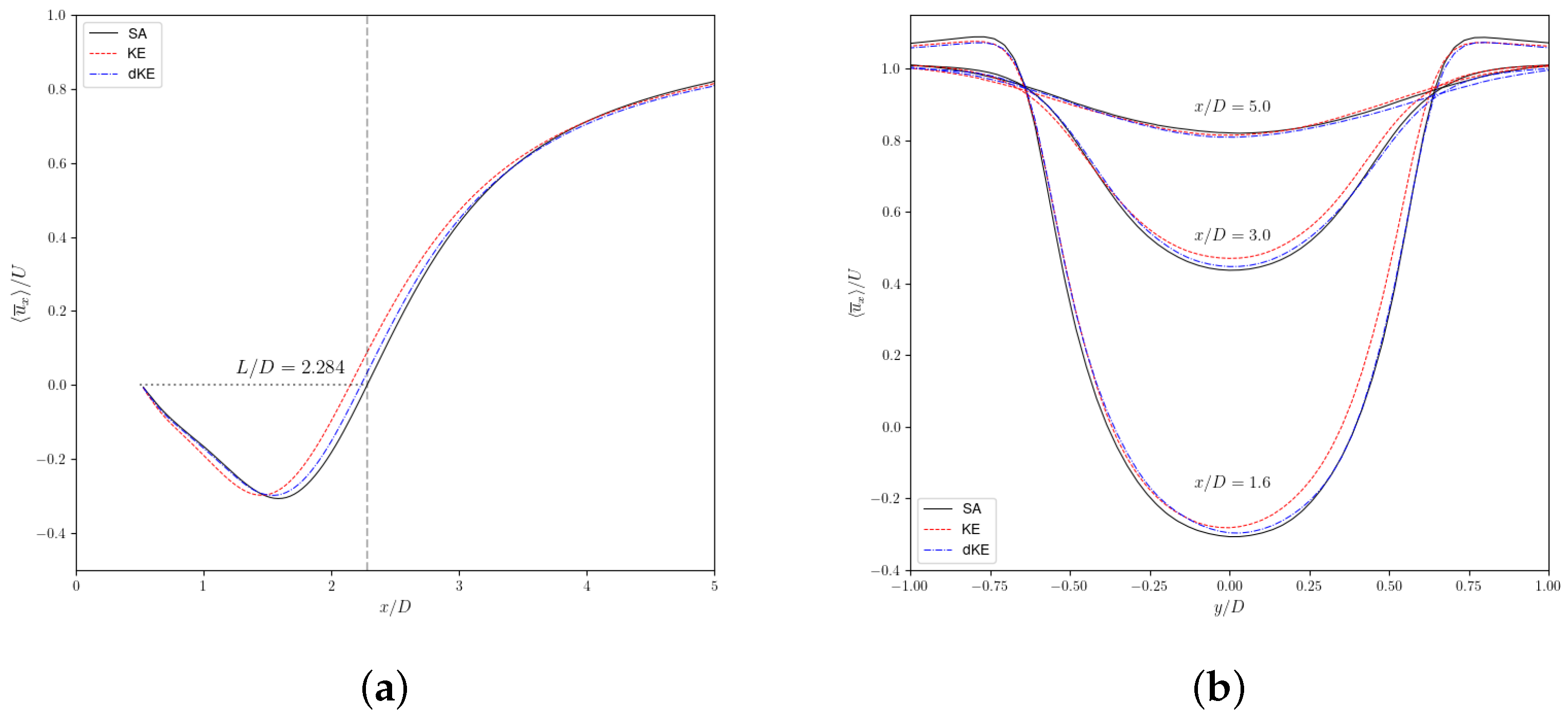
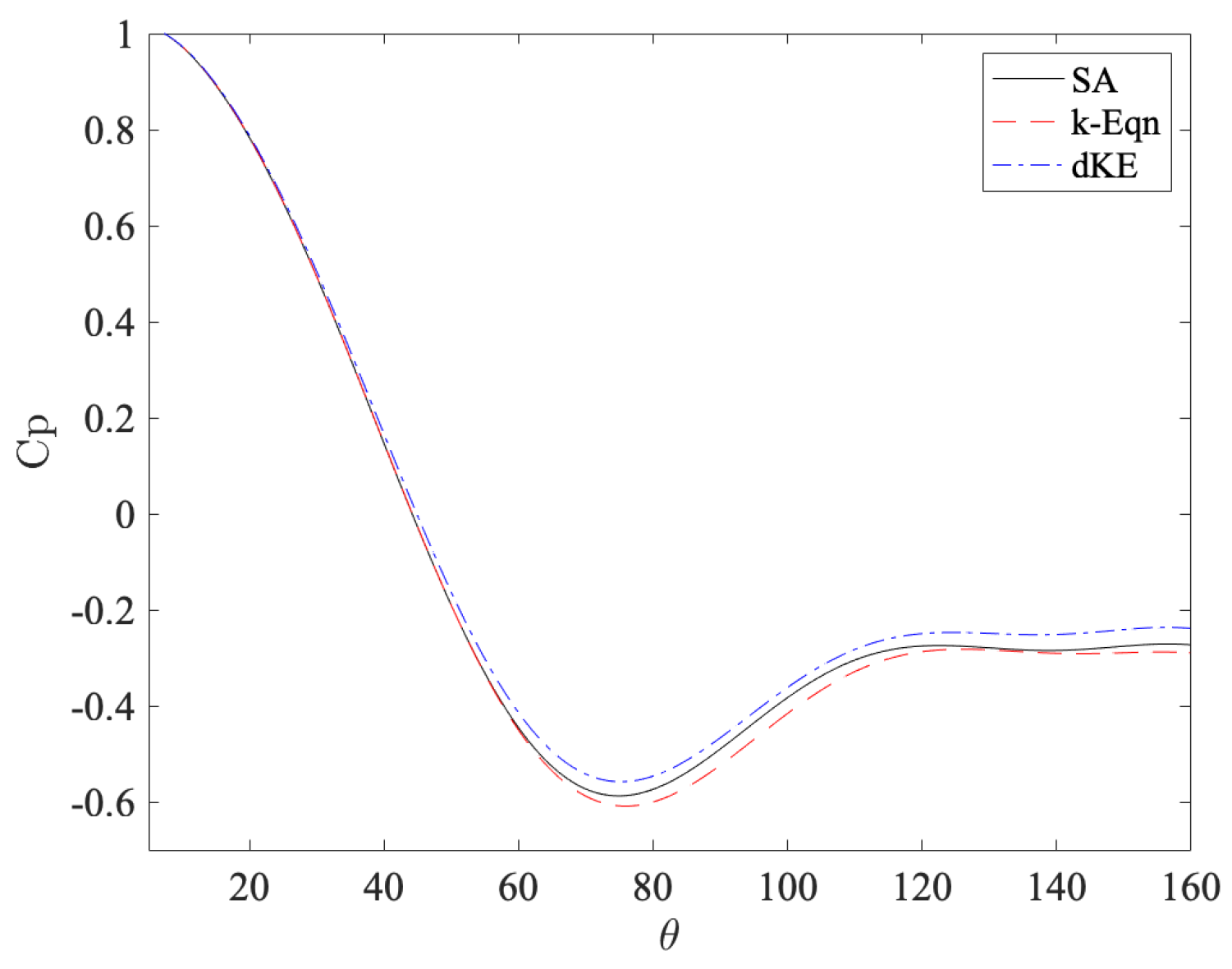

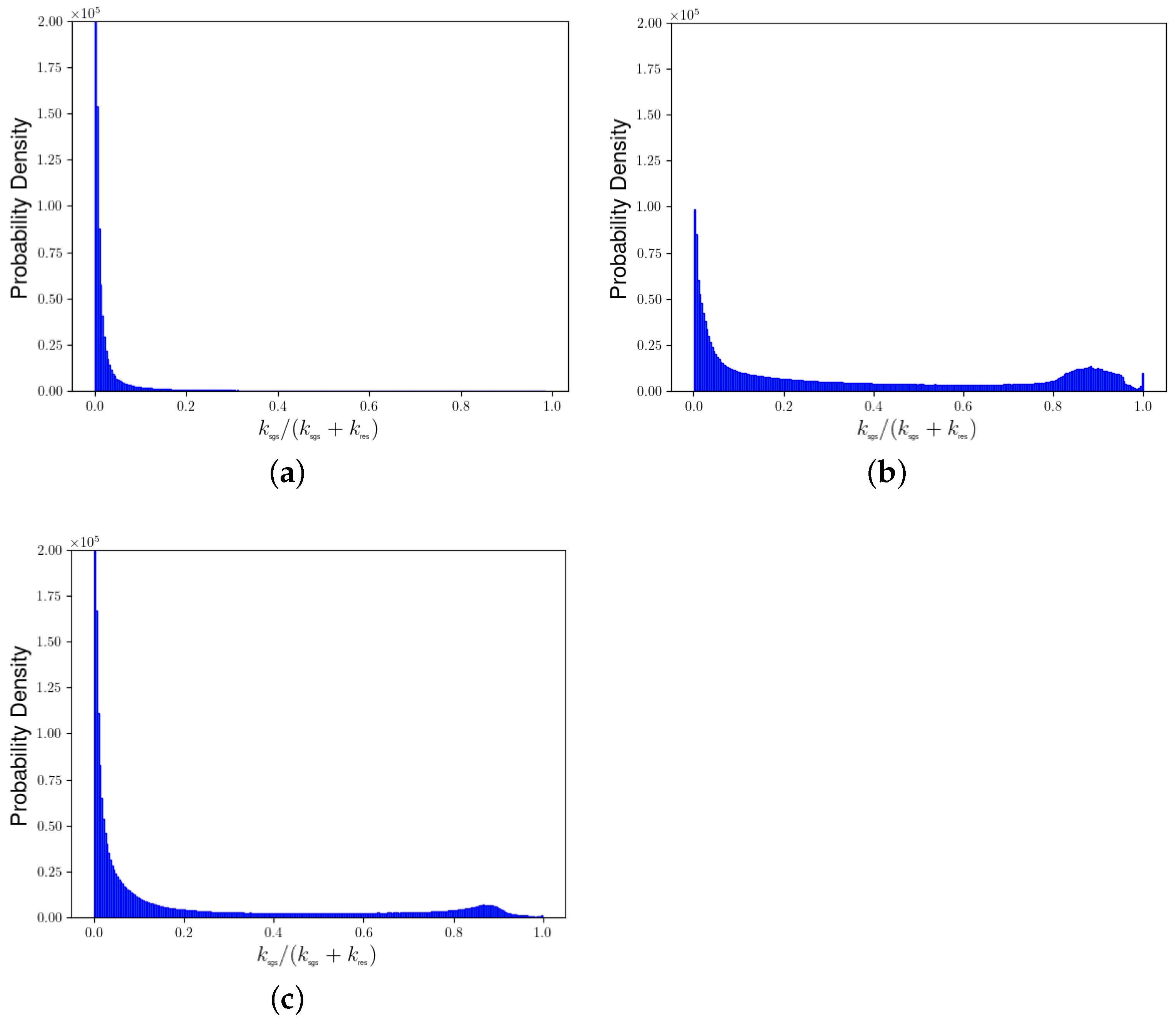
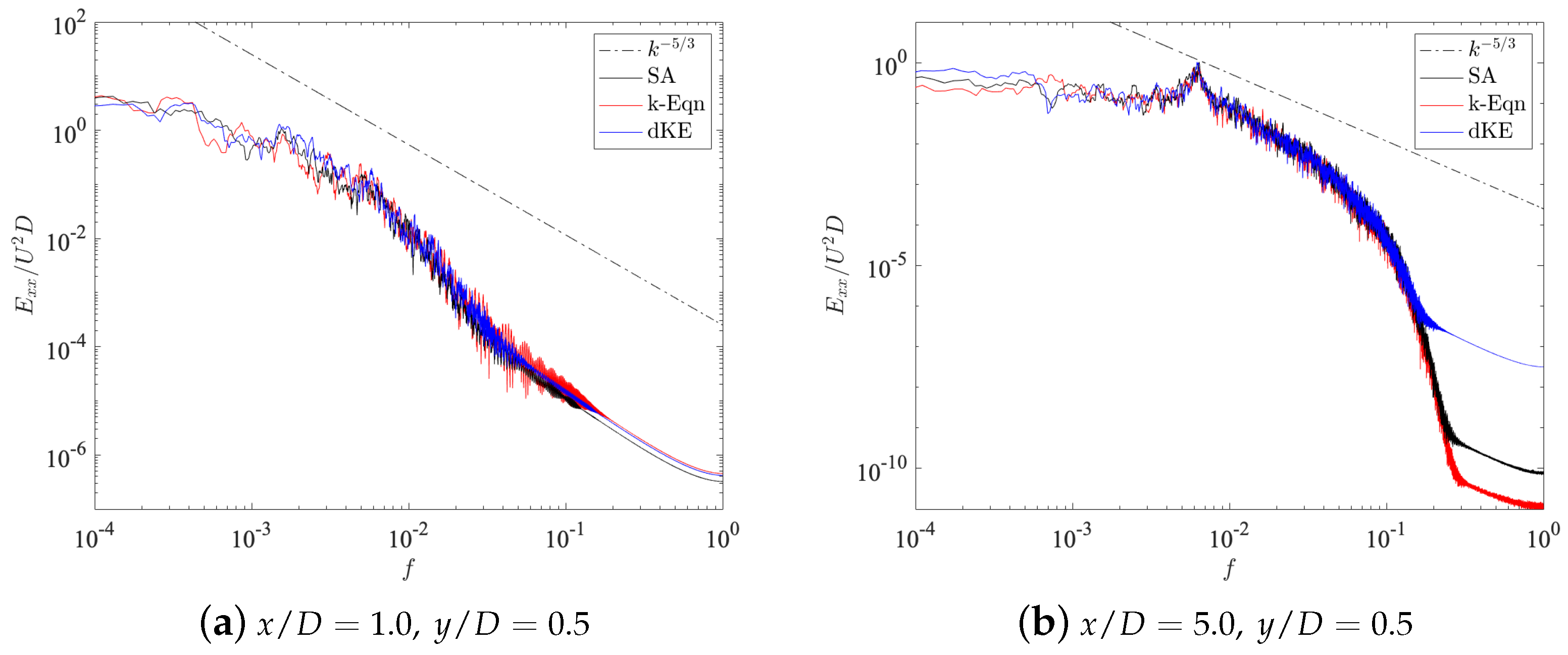
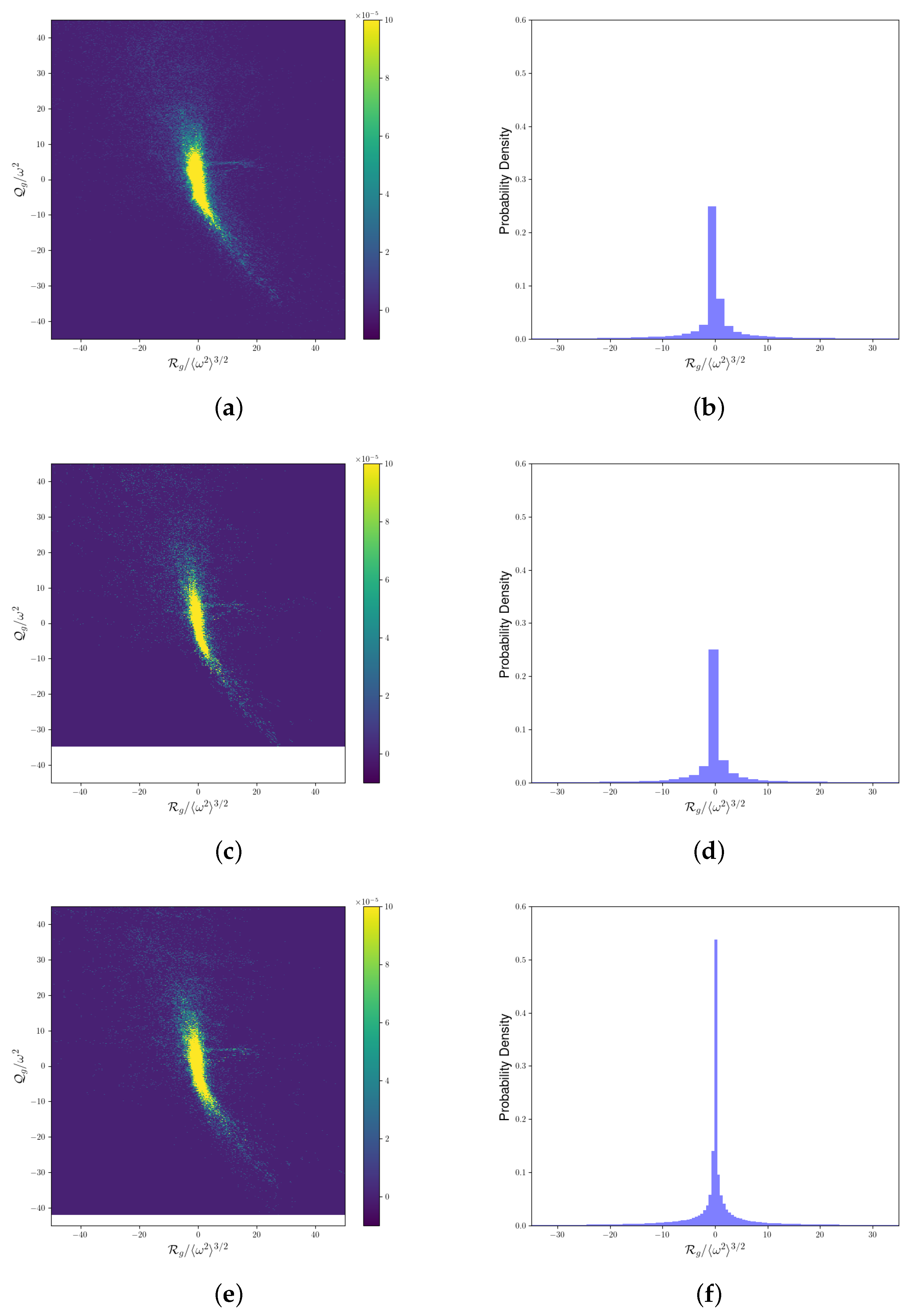

| mesh 1 | 442,368 | ||
| mesh 2 | 1,048,576 | ||
| mesh 3 | 2,048,000 | ||
| mesh 4 | 8,388,608 |
| Method | |||||
|---|---|---|---|---|---|
| Present | 0.471 | 101.9 | 2.284 | 0.207 | |
| VP [31] | 0.485 | - | 1.991 | - | |
| LES [28] | 0.355 | 90.0 | 2.622 | 0.210 | |
| DNS [33] | 0.466 | 101.4 | 2.285 | 0.200 | |
| LES [27] | - | 102.0 | 1.700 | 0.195 | |
| Exp [24] | - | - | 2.020 | - |
| Value | ||||
|---|---|---|---|---|
| Max. of streamwise turbulent intensity () | ||||
| Present | 0.057 | 1.851 | 0.382 | |
| DNS [29] | 0.055 | 2.606 | 0.423 | |
| LES [75] | 0.063 | 1.780 | 0.46 | |
| Max. of crosswise turbulent intensity () | ||||
| Present | 0.041 | 2.501 | 0.0 | |
| DNS [29] | 0.069 | 3.090 | 0.0 | |
| LES [75] | - | - | - | |
| Max. of Reynolds shear stress () | ||||
| Present | −0.024 | 2.189 | 0.410 | |
| DNS [29] | −0.029 | 2.565 | 0.392 | |
| LES [75] | −0.039 | 2.040 | 0.390 | |
| Statistic | SA | k-Eqn | dKE |
|---|---|---|---|
| Mean | 0.1074 | 0.3714 | 0.2044 |
| Median | 0.0076 | 0.2454 | 0.0411 |
| STD | 0.0767 | 0.3472 | 0.2937 |
| Skewness | Kurtosis | Skewness | Kurtosis | |
|---|---|---|---|---|
| SA | 23 | 588 | −23 | 633 |
| K-Eqn | 22 | 552 | −22 | 591 |
| dKE | 23 | 598 | −23 | 643 |
Disclaimer/Publisher’s Note: The statements, opinions and data contained in all publications are solely those of the individual author(s) and contributor(s) and not of MDPI and/or the editor(s). MDPI and/or the editor(s) disclaim responsibility for any injury to people or property resulting from any ideas, methods, instructions or products referred to in the content. |
© 2024 by the authors. Licensee MDPI, Basel, Switzerland. This article is an open access article distributed under the terms and conditions of the Creative Commons Attribution (CC BY) license (https://creativecommons.org/licenses/by/4.0/).
Share and Cite
Marefat, H.A.; Alam, J.M.; Pope, K. Toward Scale-Adaptive Subgrid-Scale Model in LES for Turbulent Flow Past a Sphere. Fluids 2024, 9, 144. https://doi.org/10.3390/fluids9060144
Marefat HA, Alam JM, Pope K. Toward Scale-Adaptive Subgrid-Scale Model in LES for Turbulent Flow Past a Sphere. Fluids. 2024; 9(6):144. https://doi.org/10.3390/fluids9060144
Chicago/Turabian StyleMarefat, H. Ali, Jahrul M Alam, and Kevin Pope. 2024. "Toward Scale-Adaptive Subgrid-Scale Model in LES for Turbulent Flow Past a Sphere" Fluids 9, no. 6: 144. https://doi.org/10.3390/fluids9060144
APA StyleMarefat, H. A., Alam, J. M., & Pope, K. (2024). Toward Scale-Adaptive Subgrid-Scale Model in LES for Turbulent Flow Past a Sphere. Fluids, 9(6), 144. https://doi.org/10.3390/fluids9060144






